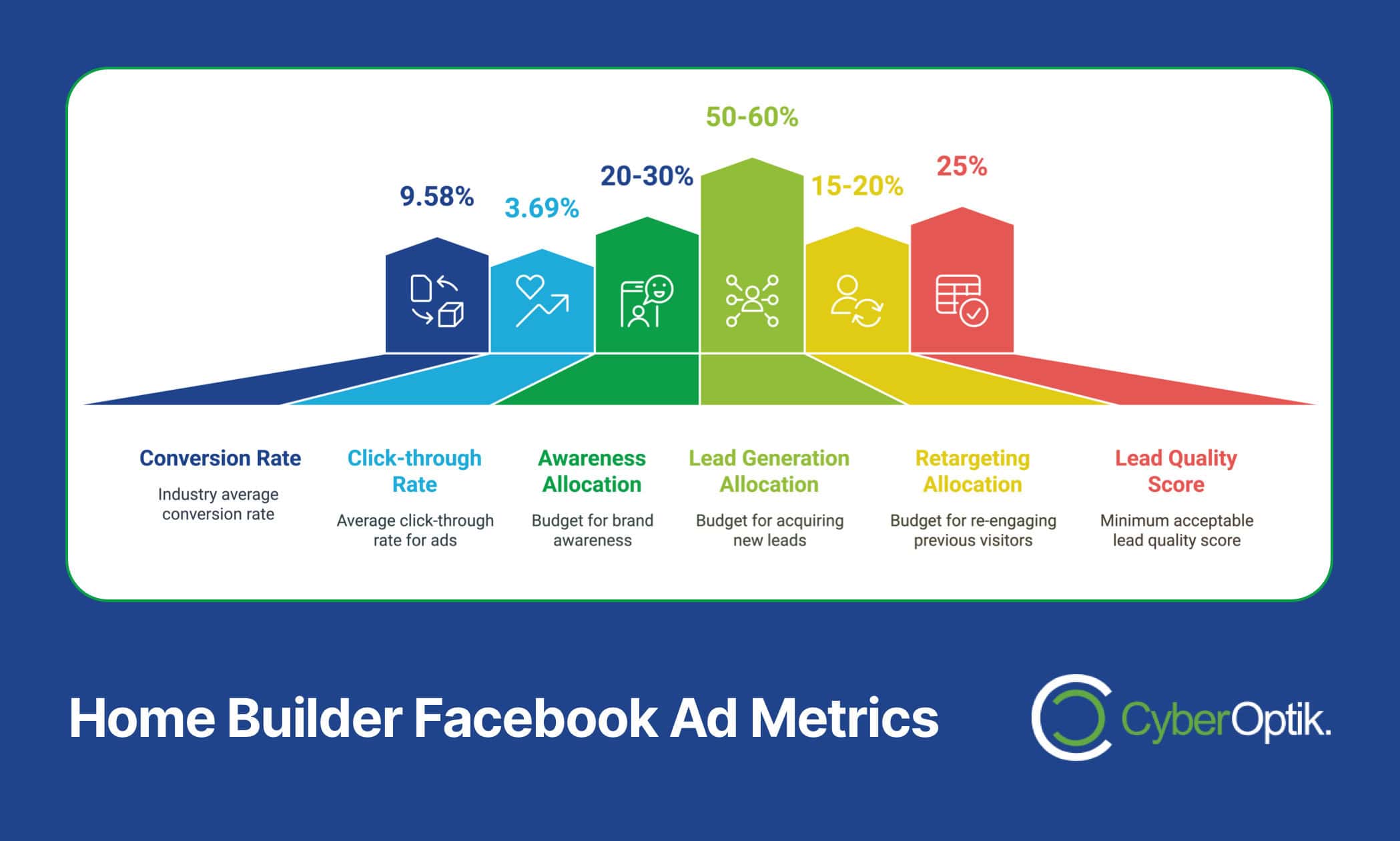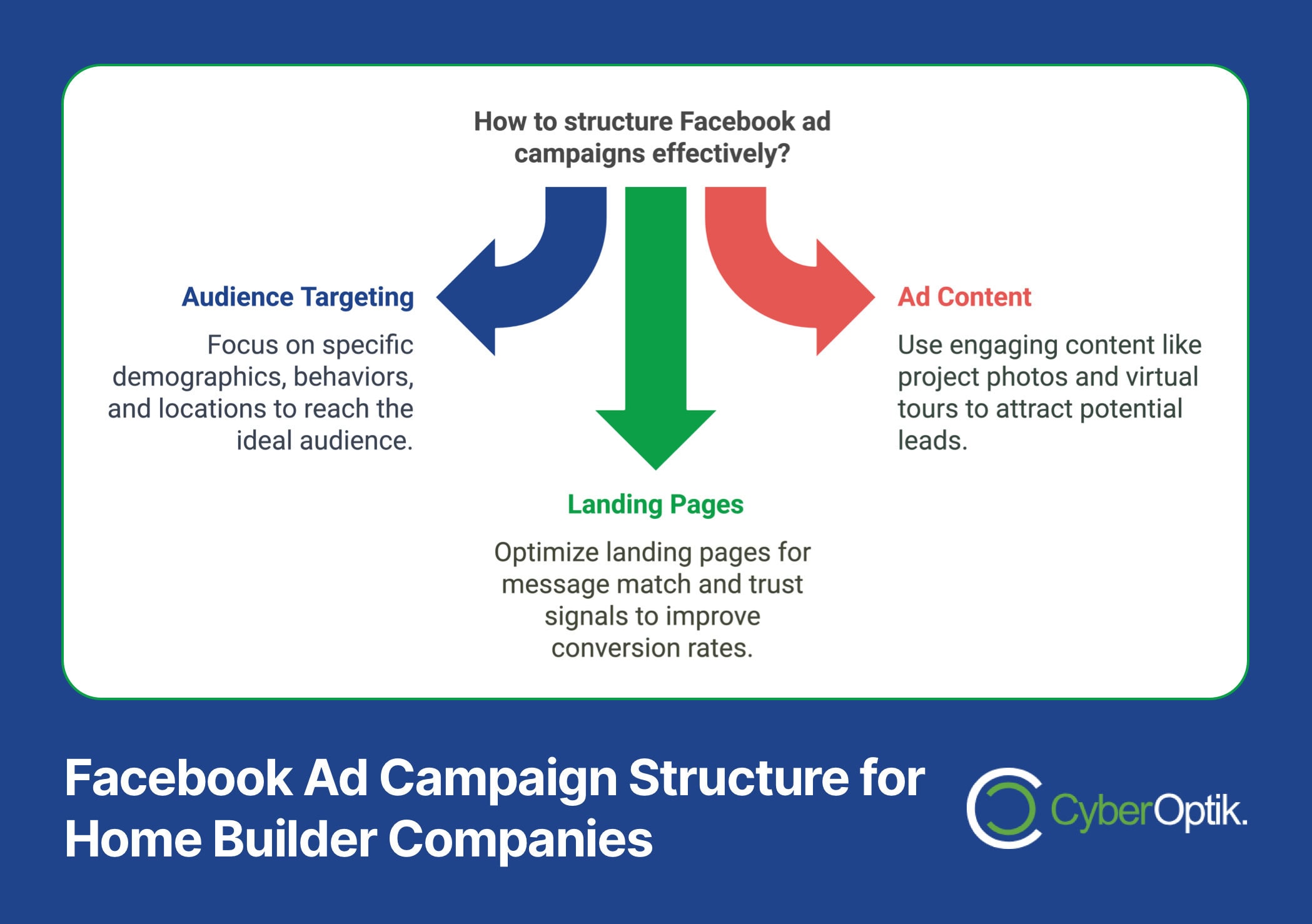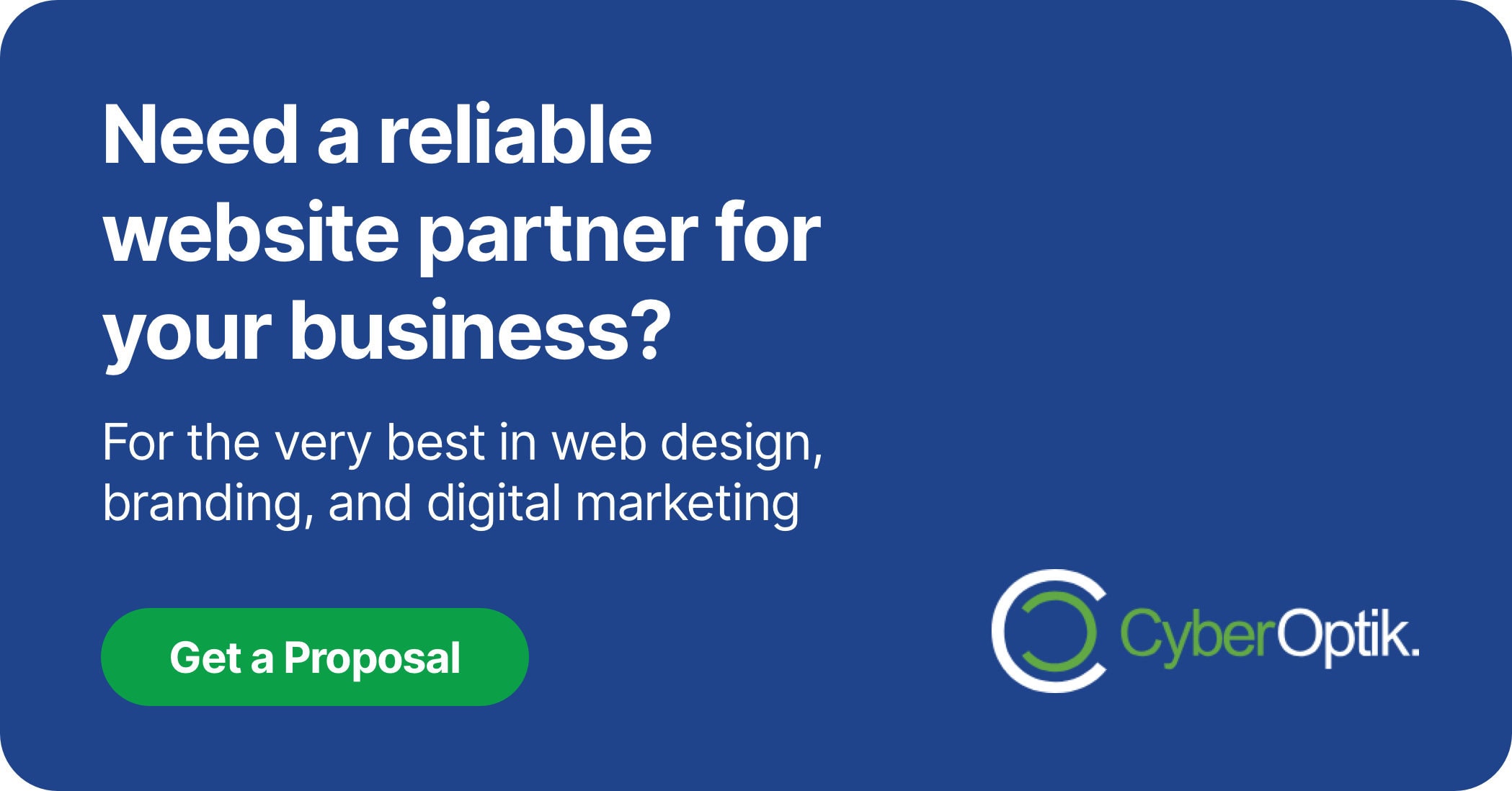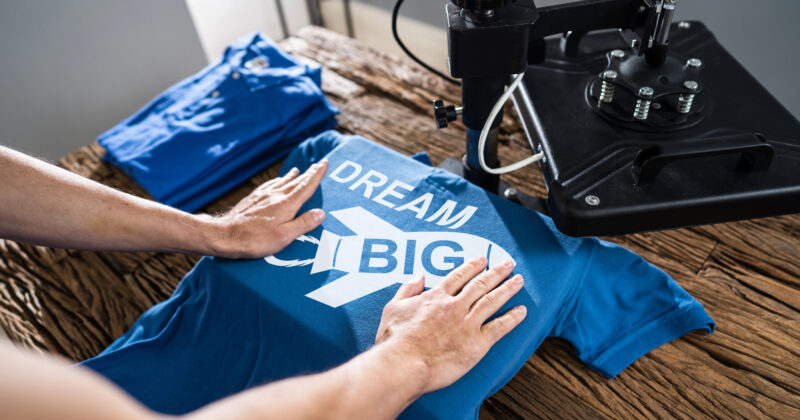Facebook Ads generate a 9.58% conversion rate for real estate businesses, making them a powerful tool for home builders seeking quality leads (Source: Association of Professional Builders). We’ve discovered that the difference between wasting ad spend and generating high-value leads lies in strategic implementation.
Through our work with Chicago’s leading home builders, we’ve developed a proven system for transforming Facebook Ads from a cost center into a reliable source of qualified leads.
This guide breaks down the exact strategies that deliver results, backed by real performance data and industry benchmarks. Whether you’re struggling with lead quality or looking to optimize your existing campaigns, these proven construction marketing techniques will help you achieve better results from your Facebook advertising investment.
Understanding the Home Builder Facebook Ads Landscape
Current State of Facebook Advertising for Builders
Here’s something we’ve uncovered working with home builders across Chicago: Facebook advertising isn’t just about reaching potential buyers—it’s about reaching the right buyers at the right time. The real estate industry sees an average cost per lead of $13.87 on Facebook (Source: Builder Funnel), but we’re seeing innovative builders significantly reduce these costs through strategic targeting and compelling content.
The current Facebook advertising landscape offers unprecedented opportunities for home builders. The platform’s sophisticated targeting capabilities allow you to reach potential buyers based on specific behaviors, such as “likely to move” or “interested in home ownership.” This precision targeting, combined with the visual nature of home building, creates a powerful platform for showcasing your projects and generating qualified leads.
Key Performance Metrics That Matter

| Metric | Industry Average | Target Range |
|---|---|---|
| Conversion Rate | 9.58% | 10-15% |
| Cost Per Lead | $13.87 | $8-12 |
| Click-Through Rate | 3.69% | 4-6% |
Success in Facebook advertising for home builders isn’t just about generating leads—it’s about generating the right leads. We’ve found that focusing on these key metrics helps our clients make data-driven decisions that improve campaign performance over time. The goal isn’t to beat industry averages but to establish sustainable benchmarks that work for your specific business model.
Common Challenges and Solutions
Through our experience managing Facebook campaigns for home builders, we’ve identified several recurring challenges that often prevent optimal performance. Understanding these challenges is the first step toward overcoming them:
- Lead Quality Issues: Implement detailed qualification questions in your lead forms
- High Cost Per Lead: Optimize targeting and ad creative based on performance data
- Low Conversion Rates: Ensure strong message match between ads and landing pages
- Inconsistent Results: Develop systematic testing and optimization processes
By addressing these challenges head-on with proven solutions, you can build a more effective Facebook advertising strategy that consistently delivers quality leads for your home building business.
Building Your Foundation: Strategic Ad Targeting
Identifying Your Ideal Client Profile
Strategic budget allocation is crucial for success, with data showing that effective campaigns dedicate 20-40% of their budget to awareness and 60-80% to lead generation (Source: Matthew J Holmes). We’ve found that this balanced approach, combined with precise targeting, creates a sustainable pipeline of qualified leads.
When building your ideal client profile, consider these essential targeting parameters:
- Demographics: Age (typically 35-65), income level ($100k+), homeownership status
- Behavioral Indicators: Recently viewed real estate listings, mortgage calculator usage
- Geographic Targeting: Primary service areas plus surrounding high-income neighborhoods
- Interest-Based Targeting: Home improvement, luxury lifestyle, investment properties
Custom Audience Creation
Your real estate website design plays a crucial role in custom audience development. We’ve discovered that combining website visitor data with customer list information creates powerful targeting opportunities. Here’s how to build effective custom audiences:
| Audience Type | Source | Timeframe |
|---|---|---|
| Website Visitors | Page Views | 30-180 days |
| Engaged Users | Social Interaction | 90 days |
| Past Clients | CRM Data | Unlimited |
By segmenting these audiences based on their interaction level, you can create targeted messaging that resonates with each group’s specific interests and needs. This approach ensures your ad spend focuses on people who have already shown interest in your services.
Lookalike Audience Optimization
Lookalike audiences represent one of Facebook’s most powerful targeting tools for home builders. We’ve developed a systematic approach to lookalike audience creation that maximizes reach while maintaining lead quality:
- Start with your highest-value customer list as the source audience
- Create multiple lookalike audiences with varying similarity levels (1%, 2%, 5%)
- Layer additional targeting criteria to refine audience quality
- Test different audience sizes against conversion metrics
The key to success with lookalike audiences lies in the quality of your source data. We recommend using lists of actual buyers or highly qualified leads rather than general website visitors for the best results. This ensures your lookalike audiences share characteristics with your most valuable customers.
Remember to regularly refresh your custom and lookalike audiences to maintain targeting effectiveness. We typically update our clients’ audience data every 30-60 days, ensuring the targeting remains current with market conditions and buyer behavior patterns.
Creating High-Converting Ad Campaigns
Effective home builder Facebook ads achieve an average cost per lead of $9.76 when properly optimized (Source: TrustMary). Through our experience implementing successful digital marketing strategies, we’ve identified the key elements that transform standard ads into lead-generating assets.

Visual Content That Drives Engagement
We’ve found that compelling visual content serves as the foundation for high-performing home builder ads. Here’s how to optimize your visual elements:
- High-Quality Photography: Professional shots of completed homes, focusing on unique features
- Virtual Tours: 360-degree walkthroughs that showcase spatial relationships
- Progress Updates: Construction timeline photos that build excitement and trust
- Lifestyle Imagery: People enjoying specific home features or community amenities
The key to visual success lies in storytelling through imagery. Rather than simply showing a finished home, we create visual narratives that help potential buyers envision their future lifestyle.
Ad Copy That Resonates with Home Buyers
| Ad Element | Best Practice | Example |
|---|---|---|
| Headlines | Clear Value Proposition | "Custom Home Built to Your Vision" |
| Primary Text | Problem-Solution Format | "Tired of cookie-cutter homes?" |
| Call-to-Action | Low-Commitment First Step | "Download Floor Plans" |
Effective ad copy combines emotional appeal with practical benefits. We structure our clients’ ad copy to address specific pain points while highlighting unique selling propositions that set them apart from production builders.
Carousel Ad Strategies for Showcasing Homes
Carousel ads offer unique opportunities for home builders to tell comprehensive stories about their properties. Here’s our proven framework for carousel ad creation:
- Lead with your strongest exterior shot to grab attention
- Follow with 3-4 interior images showcasing key living spaces
- Include a lifestyle or community shot
- End with a compelling call-to-action card
Each carousel card should work both independently and as part of the larger narrative. We recommend testing different card sequences to identify which flow generates the highest engagement rates.
For maximum impact, each carousel ad should follow these optimization principles:
- Consistent visual style across all cards
- Brief, benefit-focused copy for each image
- Progressive story development from card to card
- Mobile-first image composition
By implementing these carousel strategies, we’ve seen engagement rates increase significantly compared to single-image ads. The key lies in creating a cohesive story that guides potential buyers through the features and benefits of your homes while maintaining their interest throughout the sequence.
Landing Page Optimization for Quality Leads
Real estate ads achieve a click-through rate of 3.69% (Source: Inbound Real Estate Marketing), but the real challenge lies in converting these clicks into qualified leads. Through our experience with website optimization, we’ve developed a systematic approach to creating landing pages that not only capture leads but qualify them effectively.
Message Match Principles
The alignment between your ad content and landing page is crucial for maintaining visitor interest and trust. Here’s how we structure effective message matching:
| Ad Element | Landing Page Component | Purpose |
|---|---|---|
| Visual Style | Hero Section | Immediate Recognition |
| Key Benefits | Above-fold Content | Reinforce Value Proposition |
| Offer Details | Main Content Section | Deliver on Ad Promise |
Strong message matching reduces bounce rates and increases conversion probability by creating a seamless transition from ad to landing page. We ensure every element reinforces the initial promise that prompted the click.
Lead Qualification Elements
Quality lead generation requires strategic form design. Our proven approach includes:
- Progressive Form Fields: Start with basic information, then request more details based on engagement
- Qualifying Questions: Include budget range and preferred location to pre-screen leads
- Timeline Indicators: Ask about desired move-in or construction start dates
- Project Specifics: Gather information about style preferences and must-have features
The key is balancing the need for qualification with form completion rates. We’ve found that 4-6 strategic questions provide optimal results without significantly impacting conversion rates.
Conversion Rate Optimization Techniques
To maximize landing page performance, we implement these proven optimization strategies:
1. Social Proof Integration
- Customer testimonials with photos
- Recent project galleries
- Industry awards and certifications
2. Trust Signals
- Builder association memberships
- Warranty information
- Security badges and certifications
3. Engagement Elements
- Interactive floor plan viewers
- Virtual tour integrations
- Downloadable brochures
Each element serves a specific purpose in building trust and encouraging conversion. We continuously test and refine these components to optimize performance for each client’s unique market and audience.
For maximum effectiveness, landing pages should also include:
- Clear, benefit-focused headlines
- Mobile-optimized layouts
- Fast loading times (under 3 seconds)
- Multiple contact options (form, phone, chat)
- Emergency exit popups for abandoning visitors
By implementing these optimization techniques, we consistently see improvement in both lead quantity and quality. The focus remains on creating a conversion-friendly environment that builds trust while qualifying potential clients effectively.
Budget Allocation and Campaign Management
Strategic budget management can dramatically impact campaign performance. One successful home builder achieved leads for just $3.12 each through optimized campaign management (Source: Builder Funnel). We’ve found that proper budget allocation, combined with systematic campaign management, is crucial for maximizing your digital marketing ROI.
Setting Effective Campaign Budgets
Our experience has shown that successful budget allocation follows this structured approach:
| Campaign Type | Budget Allocation | Primary Objective |
|---|---|---|
| Brand Awareness | 20-30% | Market Presence |
| Lead Generation | 50-60% | Quality Leads |
| Retargeting | 15-20% | Conversion |
This balanced approach ensures consistent brand visibility while maintaining focus on lead generation. We adjust these percentages based on seasonal factors and market conditions.
Cost Per Lead Optimization
To achieve optimal cost per lead, we implement these proven strategies:
Audience Refinement
- Regular performance analysis of demographic segments
- Exclusion of non-converting audiences
- Continuous testing of new targeting combinations
Bid Strategy Optimization
- Start with automatic bidding to gather data
- Transition to manual bidding for high-performing segments
- Implement bid adjustments based on performance patterns
Performance Tracking and Analytics
Effective campaign management requires robust tracking and analysis. Here’s our systematic approach:
1. Key Metrics Monitoring
- Cost per lead by campaign type
- Lead quality scores
- Conversion rates at each funnel stage
- Return on ad spend (ROAS)
2. Performance Analysis Cycle
- Daily: Budget pacing and basic metrics
- Weekly: Campaign performance review
- Monthly: Strategic assessment and optimization
- Quarterly: Major strategy review and adjustment
We’ve developed a comprehensive tracking framework that focuses on these critical areas:
- Lead Source Attribution: Tracking which campaigns generate the highest quality leads
- Conversion Path Analysis: Understanding the journey from first click to contract
- Cost Analysis: Detailed breakdown of expenses versus lead quality
- ROI Measurement: Connecting ad spend to actual sales outcomes
By implementing these tracking and optimization strategies, we help our clients maintain efficient campaign performance while continuously improving lead quality. The key lies in making data-driven decisions based on actual performance metrics rather than assumptions.
Lead Nurturing and Follow-up Systems
With Facebook ads achieving an average conversion rate of 9.21% across industries (Source: Inbound Real Estate Marketing), effective lead nurturing becomes crucial for converting these leads into contracts. Our experience with marketing automation has shown that systematic follow-up processes significantly improve conversion rates.
Facebook Messenger Integration
We’ve developed a strategic approach to Messenger communication that maintains engagement while qualifying leads:
| Message Type | Timing | Purpose |
|---|---|---|
| Initial Response | Immediate | Acknowledge Interest |
| Qualification Questions | Within 5 Minutes | Basic Screening |
| Follow-up Information | Within 24 Hours | Value Addition |
Our Messenger strategy focuses on maintaining momentum while providing value at each interaction point. This approach helps maintain engagement while moving leads through the qualification process.
Email Marketing Connection
Strategic email nurturing plays a crucial role in the conversion process. Here’s our proven email sequence structure:
1. Welcome Series
- Introduction to your building process
- Showcase of recent projects
- Client success stories
2. Education Series
- Custom home building guides
- Design trend updates
- Construction timeline expectations
3. Conversion Series
- Exclusive offers
- Limited-time incentives
- Consultation scheduling
Lead Scoring Implementation
We implement a comprehensive lead scoring system that helps prioritize follow-up efforts:
Behavioral Scoring
- Website page visits
- Email engagement
- Social media interaction
- Content downloads
Demographic Scoring
- Location relevance
- Budget alignment
- Timeline readiness
- Project scope match
Our lead scoring matrix helps identify the most promising prospects for immediate follow-up while maintaining engagement with longer-term opportunities. We typically use this scoring framework:
| Score Range | Lead Category | Follow-up Priority |
|---|---|---|
| 80-100 | Hot Lead | Immediate Personal Contact |
| 60-79 | Warm Lead | Within 24 Hours |
| 40-59 | Nurture Lead | Automated Sequence |
By implementing these nurturing systems, we create a consistent process for moving leads from initial interest to sales-ready status. The key is maintaining regular, valuable communication while respecting the prospect’s timeline and preferences.
Measuring Success and Scaling Results
Successful Facebook ad campaigns can generate significant engagement, as demonstrated by one home builder achieving 1,200 clicks from 67,000 impressions (Source: Builder Funnel). Understanding key metrics and implementing proper conversion optimization techniques is crucial for scaling your success.
Key Performance Indicators
We focus on these critical metrics to measure campaign effectiveness:
| Metric Category | Key Indicators | Target Benchmark |
|---|---|---|
| Engagement | Click-through Rate | 3.5%+ |
| Conversion | Lead Conversion Rate | 9%+ |
| Quality | Sales Qualification Rate | 25%+ |
Success measurement extends beyond basic metrics to include these crucial factors:
Lead Quality Indicators
- Average project value
- Sales cycle duration
- Contract conversion rate
- Customer lifetime value
Campaign Efficiency Metrics
- Cost per qualified lead
- Return on ad spend
- Customer acquisition cost
- Campaign scalability potential
Expanded Testing and Optimization Framework for Home Builder Facebook Ads
Our framework for optimizing Facebook ad campaigns is thorough and data-driven, ensuring that every element of the campaign is engineered for maximum impact and efficiency.
Creative Testing
Creative elements are the frontline of your ad’s effectiveness. Our testing protocol involves a meticulous examination of various creative components:
- Image Variations: We test multiple images to identify which visuals capture attention best, including different angles and staging of homes, and lifestyle imagery that connects emotionally with potential buyers.
- Ad Copy Elements: Different headlines, value propositions, and calls to action are tested to determine which messages resonate most effectively with the target audience.
- Call-to-Action Options: Various calls to action are experimented with to find the ones that drive the highest conversion rates. Options like “Schedule a Viewing,” “Download a Brochure,” or “Contact Us Today” are tailored to different stages of the buyer’s journey.
- Format Effectiveness: We evaluate the performance across different ad formats—such as single image, carousel, video, or slideshow—to determine which formats engage users the most and lead to deeper interaction.
Audience Testing
Understanding and refining the audience segments can significantly enhance campaign performance:
- Demographic Combinations: We test ads across different demographic segments, analyzing age, income levels, and other relevant characteristics to refine our targeting strategies.
- Interest Overlaps: By identifying overlapping interests, such as home design, real estate investment, or luxury living, we can better tailor our messaging.
- Behavior Patterns: We analyze behaviors like past interactions with real estate ads, duration on real estate listings, and engagement with mortgage calculators to enhance targeting precision.
- Lookalike Variations: Different degrees of similarity in lookalike audiences are tested to find the perfect balance between reach and relevance, optimizing the quality of leads generated.
Placement Optimization
The choice of where the ads appear plays a crucial role in performance:
- Platform Performance: We assess which platforms within the Facebook ecosystem, including Instagram and Messenger, yield the best results for specific types of ads.
- Device Preferences: Understanding whether users engage more on mobile or desktop helps us optimize the ad design for different screen sizes and operating systems.
- Time-of-Day Analysis: We pinpoint the times when potential buyers are most likely to engage with ads, optimizing ad spend for these peak times.
- Day-of-Week Patterns: Identifying which days of the week perform best for ad engagement allows us to allocate more budget efficiently and improve overall ad visibility.
Scaling Successful Campaigns
Once the initial testing phase has proven successful, scaling the campaign effectively is critical to maximizing reach while maintaining control over the budget and lead quality.
- Gradual Budget Increases: We implement budget increases in increments of 20% every 3-4 days, closely monitoring the impact on performance metrics to ensure efficiency.
- Monitor Performance Metrics: Continuous monitoring allows us to make real-time adjustments based on concrete data, optimizing the return on investment continuously.
- Adjust Based on Efficiency Metrics: By analyzing metrics like cost per lead and click-through rate, we adjust targeting, bidding, and creative strategies to improve efficiency.
- Maintain Cost Per Acquisition Targets: Keeping a close eye on CPA ensures that scaling doesn’t lead to diminished returns but rather enhances the campaign’s profitability.
Audience Expansion
Expanding the audience strategically is vital for growing the campaign’s reach without sacrificing lead quality:
- Systematic Testing of New Segments: New demographic and interest segments are introduced and tested systematically to explore potential new markets.
- Careful Monitoring of Quality Indicators: As the audience expands, maintaining the quality of leads is paramount. We monitor indicators such as engagement rates and conversion rates to ensure high-quality leads.
- Geographic Expansion Strategies: Expanding into new geographic areas is done strategically, starting with similar markets before moving into diverse demographics.
- Interest-Based Scaling: Scaling efforts are also based on refining and expanding on the interests that have shown the highest engagement and conversion rates.
By adhering to this comprehensive testing and optimization framework, home builders can not only enhance their Facebook advertising campaigns but also ensure sustainable growth and efficiency, maximizing both reach and return on investment in a competitive digital marketplace.
Frequently Asked Questions About Home Builder Facebook Ads
Based on our experience helping home builders optimize their social media marketing campaigns, here are answers to the most common questions we receive:
What’s the typical budget needed to start Facebook advertising for home builders?
We recommend starting with a minimum monthly budget of $1,500-2,000 for home builders. This allows sufficient funds to test different audience segments, ad creatives, and messaging while maintaining consistent presence. The key is having enough budget to gather meaningful data for optimization while managing cost per lead effectively.
How long does it take to see results from Facebook ads?
Initial results typically appear within the first 2-4 weeks of campaign launch. However, optimal performance usually requires 60-90 days of data collection and optimization. This timeline allows for proper audience testing, creative refinement, and conversion rate optimization while building a sustainable lead generation system.
What’s the best way to qualify leads from Facebook ads?
Lead qualification should happen at multiple touchpoints:
- Pre-qualification through targeted ad messaging
- Strategic form fields on landing pages
- Automated email sequences with qualifying questions
- Phone or video consultation scheduling
How can we improve lead quality from Facebook ads?
Lead quality improvement comes from:
- Precise audience targeting based on demographics and behaviors
- Clear communication of price points and project minimums in ad copy
- Detailed qualification questions in lead capture forms
- Strong follow-up systems to nurture and qualify leads
What’s the most effective type of Facebook ad for home builders?
Carousel ads typically perform best for home builders as they allow you to:
- Showcase multiple projects or home features
- Tell a complete story about your building process
- Display before and after transformations
- Highlight different aspects of your services
Transform Your Home Building Business with Strategic Facebook Ads
Implementing an effective Facebook advertising strategy requires careful planning, consistent optimization, and systematic execution. The key elements we’ve covered in this guide provide a framework for success:
- Strategic audience targeting and segmentation
- Compelling ad creative and messaging
- Optimized landing pages for lead capture
- Effective budget management and scaling
- Systematic lead nurturing and follow-up
Ready to transform your Facebook advertising results? Our team specializes in creating and managing high-performing Facebook ad campaigns for home builders. We combine industry expertise with data-driven optimization to deliver qualified leads that convert into contracts.
Take the Next Step
Schedule a free consultation to discuss how we can help you:
- Optimize your Facebook ad campaigns
- Improve lead quality and conversion rates
- Scale your home building business through digital marketing
Contact us today to start generating better results from your Facebook advertising investment.




